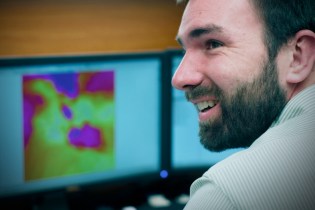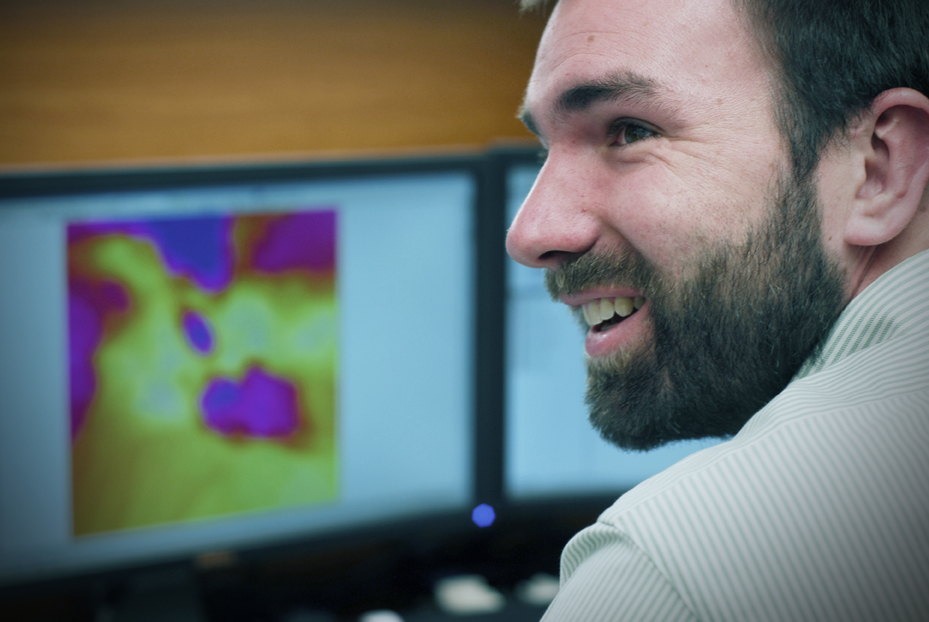
Biostatistician Ian Craig with the National Institute on Drug Abuse. (Photo by J.M. Giordano.)
The original version of this story appeared in Urbanite.
By some measures, Baltimore has more heroin users than any other American city. Yet city residents here, like in most urban centers in the United States, don’t really see them. They are a part of the complex drug ecosystem: They are buyers and sellers, participants in treatment programs, inhabitants of jail and prison cells. Yet the “junkies” hide away in America’s ideological predispositions, our moral judgments, and our assumptions about addicts and addiction.
While drug addiction is one of urban America’s most persistent and politically fraught problems, the truth is that we have only a tenuous understanding of how it works. Science has begun to shed important light on the genetics and biochemistry of addiction, but we assert more than we actually know about how addiction really works in the streets.
Here in Baltimore, that’s changing, as researchers literally map the ecology of addiction. Their work is making Baltimore drug users visible in new ways, and potentially changing how we think about addiction, relapse, treatment, and prevention.
“If you want to intervene in something, you really need to know how it works,” says David Epstein, a researcher with the National Institute on Drug Abuse (NIDA). “Our goal is to go back and see if the assumptions we’ve made as clinicians and scientists are true.”
To do that, Epstein, along with lead investigator Kenzie L. Preston and biostatistician Ian Craig, have issued GPS tracking devices to drug users who have sought out-patient treatment at the NIDA clinic in Baltimore. Participants are also given smart phones that randomly prompt them to answer questions about their mood, their stress level, and cues in their environment that may lead to relapse. They also activate their phone if they get high, or even if they are tempted to.
In addiction research, this type of repeated sampling of subjects’ behaviors and experiences in real time, in the real world, is called “ecological momentary assessment.” Combine it with the geographical data from a participant’s GPS, and the result is a mental map, a cognitive cartography of an addict’s life in the city.
“There are significant studies of animals, about how they move and where they move in particular environments. We wanted to do something similar with our human participants,” says Preston. “I had this idea that when people were using drugs they had certain patterns of places they went, and when they stopped [using drugs] as part of treatment, that pattern would change.”
To make the patterns of movement meaningful, the researchers have to understand the various city “environments” that the drug users move through. This job fell to Craig, the biostatistician and a Baltimore native. To create maps of the urban landscape, Craig started with Census indices, including race, income, and other socioeconomic metrics. To those he added a system developed by Debra Furr-Holden at the Johns Hopkins School of Public Health, who sent teams out to score city blocks based on physical characteristics (broken windows, shell casings, street memorials for recent killings) and on people’s behavior (clearly intoxicated adults, unsupervised children, and so on). “Her data are like nothing else I’ve ever seen,” says Epstein.
On these maps, Craig plots the paths of drug users as they move through the city, weaving in the information they’ve plugged into their smartphones. The result is a detailed rendering of how addiction is lived in space and time, opening a new window on the experience of tens of thousands of city residents.
What has that window revealed? Right away, the mapping of the ecology of heroin addiction started to reveal some of its specific patterns. For example, Epstein said, in Baltimore “you have neighborhoods that have drugs without violence, but not many neighborhoods that have violence without drugs.”
Epstein is reluctant to get too specific about the team’s other findings until they are peer-reviewed and published — which should happen soon, he says — but he says that the media coverage of their work, while gratifying, has missed some important nuance. “The one thing people do want to know … is how to turn this directly into an intervention,” he says. But the most important thing the research does, he says, is provide context for what we are learning about genetics, brain function, and other human hard-wiring.
“A lot of scientist want to know about your genes or your brain on a sociological level,” Epstein observes. “What we are doing allows us to measure and control for aspects of the environment, the noise of the environment … We need a way to capture and measure the relative value and intensity of the signals in that noise,” he says. “You can get a much more sensitive measure of what [scientists] are interested in.
“Someday, I would love to see our mapping and electronic-diary techniques integrated into a large epidemiological study,” Epstein says. “My belief, which could be tested in a study like that, is that the risk of becoming addicted is largely a matter of biological ‘wiring’ for individuals in higher socioeconomic groups, but more a matter of environment for people who live in poverty. That statement probably sounds obvious, but it’s rarely said, and we could use a lot more data to back it up. It has major implications for prevention and probably for treatment.”
“Their work is novel,” says Yale University’s Rajita Sinha, professor of psychiatry and child study at Yale who has done pioneering research on the mechanisms linking stress to addiction. This research “allows us to understand the social context in which drug use takes place and to evaluate that context.”
“The time has come for us to integrate what we know about cells, DNA, and our brains with the social context,” Sinha adds. Do this, she says, and “health policy experts and scientists can combine their efforts in new and effective ways.”
Perhaps then, we will see addiction for what it really is — and urban America can begin to abandon its metaphors of war and really understand how drugs and drug use are woven into the fabric of city life.




